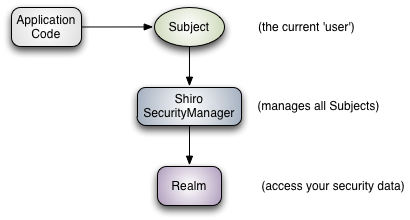1.什么是shiro?
Shiro是一个功能强大、灵活的,开源的安全框架,主要可以帮助我们解决程序开发中认证和权限等问题。基于拦截器做的权限系统,权限控制的粒度有限,为了方便各种各样的常用的权限管理需求的实现,我们有必要使用比较好的安全框架。
早期Spring security 作为一个比较完善的安全框架比较火,但是Springsecurity学习成本比较高,于是就出现了shiro安全框架,学习成本降低了很多,而且基本的功能也比较完善。
Shiro的架构
Subject:主题。被验证的对象,一般指的当前用户对象。但是不仅仅可以指当前用户对象,还可以是其他东西,线程等等。spring mvc中一个一个的用户的请求。SecurityManager:安全认证管理器。是shiro的核心,会在安全认证管理器中所做所有的认证操作。类似于之前Spring MVC中的前端控制器(DispacherServlet)。Realm:域的意思。负责访问安全认证数据。shiro框架并不存在安全认证数据,安全认证数据需要用户自己存储。shiro支持很多的Realm实现,也就是说安全认证数据我们可以放到数据库中,也可以放到文件中等等。可以把realm理解为以前web项目的dao层。
Shiro的功能
- Authentication:身份认证/登陆,验证用户是不是拥有相对应的身份,通常被称为用户“登录”;
- Authorization:授权,即权限验证,验证某个已认证的用户是否拥有某个权限;即判断用户是否能做事情,常见的如:验证某个用户是否拥有某个角色。或者粒度的验证某个用户对某个资源是否具有权限;
- Session Manager:会话管理,即用户登陆后就是一次会话,在没有退出之前,它的所有信息都在会话中;会话可以是普通JavaSE环境的,也可以是Web环境的;
- Cryptographt:加密,保护数据,如密码加密存储到数据库,而不是明文存储;
- Web Support:Web支持,可以保护 Web 应用程序的安全;
- Caching:缓存,比如用户登陆后,其用户信息、拥有的角色/权限不必每次去查,这样提高效率;
- Concurrency:多线程应用的并发验证,即如在一个线程中开启另一个线程,能把权限自动传播过去;
- Testing:支持单元测试和集成测试,确保代码和预想的一样安全;
- Run As:允许一个用户假装另一个用户(如果我们允许)的身份进行访问;
- Remember Me:记住我,这个是非常常见的功能,即一次登陆后,下次再来的话不用登陆了。
2.环境搭建
mysql database
docker run --name docker-mysql-5.7 -e MYSQL_ROOT_PASSWORD=123456 -p 3306:3306 -d mysql:5.7
init data
create database demo;
CREATE TABLE `sys_permission` (
`id` int(11) NOT NULL AUTO_INCREMENT,
`available` tinyint(4) DEFAULT NULL,
`name` varchar(100) DEFAULT NULL,
`parent_id` int(11) DEFAULT NULL,
`permission` varchar(100) DEFAULT NULL,
`resource_type` varchar(100) DEFAULT NULL,
`url` varchar(100) DEFAULT NULL,
`parent_ids` varchar(100) DEFAULT NULL,
PRIMARY KEY (`id`)
) ENGINE=InnoDB AUTO_INCREMENT=4 DEFAULT CHARSET=utf8;
CREATE TABLE `sys_role` (
`id` int(11) NOT NULL AUTO_INCREMENT,
`available` tinyint(4) DEFAULT NULL,
`description` varchar(100) DEFAULT NULL,
`role` varchar(100) DEFAULT NULL,
PRIMARY KEY (`id`)
) ENGINE=InnoDB AUTO_INCREMENT=4 DEFAULT CHARSET=utf8;
CREATE TABLE `sys_role_permission` (
`permission_id` int(11) DEFAULT NULL,
`role_id` int(11) DEFAULT NULL
) ENGINE=InnoDB DEFAULT CHARSET=utf8;
CREATE TABLE `sys_user_role` (
`uid` int(11) DEFAULT NULL,
`role_id` int(11) DEFAULT NULL
) ENGINE=InnoDB DEFAULT CHARSET=utf8;
CREATE TABLE `user_info` (
`uid` int(11) NOT NULL AUTO_INCREMENT,
`username` varchar(100) CHARACTER SET latin1 DEFAULT NULL,
`name` varchar(200) DEFAULT NULL,
`password` varchar(100) CHARACTER SET latin1 DEFAULT NULL,
`salt` varchar(100) CHARACTER SET latin1 DEFAULT NULL,
`state` tinyint(4) DEFAULT NULL,
PRIMARY KEY (`uid`)
) ENGINE=InnoDB AUTO_INCREMENT=2 DEFAULT CHARSET=utf8;
INSERT INTO `user_info` (`uid`,`username`,`name`,`password`,`salt`,`state`) VALUES ('1', 'admin', '管理员', 'd3c59d25033dbf980d29554025c23a75', '8d78869f470951332959580424d4bf4f', 0);
INSERT INTO `sys_role` (`id`,`available`,`description`,`role`) VALUES (1,0,'管理员','admin');
INSERT INTO `sys_role` (`id`,`available`,`description`,`role`) VALUES (2,0,'VIP会员','vip');
INSERT INTO `sys_role` (`id`,`available`,`description`,`role`) VALUES (3,1,'test','test');
INSERT INTO `sys_permission` (`id`,`available`,`name`,`parent_id`,`parent_ids`,`permission`,`resource_type`,`url`) VALUES (1,0,'用户管理',0,'0/','userInfo:view','menu','userInfo/userList');
INSERT INTO `sys_permission` (`id`,`available`,`name`,`parent_id`,`parent_ids`,`permission`,`resource_type`,`url`) VALUES (2,0,'用户添加',1,'0/1','userInfo:add','button','userInfo/userAdd');
INSERT INTO `sys_permission` (`id`,`available`,`name`,`parent_id`,`parent_ids`,`permission`,`resource_type`,`url`) VALUES (3,0,'用户删除',1,'0/1','userInfo:del','button','userInfo/userDel');
INSERT INTO `sys_user_role` (`role_id`,`uid`) VALUES (1,1);
INSERT INTO `sys_role_permission` (`permission_id`,`role_id`) VALUES (1,1);
INSERT INTO `sys_role_permission` (`permission_id`,`role_id`) VALUES (2,1);
INSERT INTO `sys_role_permission` (`permission_id`,`role_id`) VALUES (3,2);
remark
msyql account:root
mysql password:1234563.代码工程
实验目的:使用shiro控制访问权限
pom.xml
<?xml version="1.0" encoding="UTF-8"?>
<project xmlns="http://maven.apache.org/POM/4.0.0"
xmlns:xsi="http://www.w3.org/2001/XMLSchema-instance"
xsi:schemaLocation="http://maven.apache.org/POM/4.0.0 http://maven.apache.org/xsd/maven-4.0.0.xsd">
<parent>
<artifactId>springboot-demo</artifactId>
<groupId>com.et</groupId>
<version>1.0-SNAPSHOT</version>
</parent>
<modelVersion>4.0.0</modelVersion>
<artifactId>shiro</artifactId>
<properties>
<maven.compiler.source>8</maven.compiler.source>
<maven.compiler.target>8</maven.compiler.target>
</properties>
<dependencies>
<dependency>
<groupId>org.springframework.boot</groupId>
<artifactId>spring-boot-starter-web</artifactId>
</dependency>
<dependency>
<groupId>org.springframework.boot</groupId>
<artifactId>spring-boot-autoconfigure</artifactId>
</dependency>
<dependency>
<groupId>org.springframework.boot</groupId>
<artifactId>spring-boot-starter-test</artifactId>
<scope>test</scope>
</dependency>
<dependency>
<groupId>org.apache.shiro</groupId>
<artifactId>shiro-spring</artifactId>
<version>1.4.0</version>
</dependency>
<dependency>
<groupId>org.springframework.boot</groupId>
<artifactId>spring-boot-starter-data-jpa</artifactId>
</dependency>
<dependency>
<groupId>org.springframework.boot</groupId>
<artifactId>spring-boot-starter-thymeleaf</artifactId>
</dependency>
<dependency>
<groupId>mysql</groupId>
<artifactId>mysql-connector-java</artifactId>
<version>8.0.33</version>
</dependency>
</dependencies>
</project>shiro config
调用userservice读取用户信息
package com.et.shiro.config;
import com.et.shiro.entity.SysPermission;
import com.et.shiro.entity.SysRole;
import com.et.shiro.entity.UserInfo;
import com.et.shiro.service.UserInfoService;
import org.apache.shiro.authc.AuthenticationException;
import org.apache.shiro.authc.AuthenticationInfo;
import org.apache.shiro.authc.AuthenticationToken;
import org.apache.shiro.authc.SimpleAuthenticationInfo;
import org.apache.shiro.authz.AuthorizationInfo;
import org.apache.shiro.authz.SimpleAuthorizationInfo;
import org.apache.shiro.realm.AuthorizingRealm;
import org.apache.shiro.subject.PrincipalCollection;
import org.apache.shiro.util.ByteSource;
import javax.annotation.Resource;
public class MyShiroRealm extends AuthorizingRealm {
@Resource
private UserInfoService userInfoService;
//check username and password
@Override
protected AuthenticationInfo doGetAuthenticationInfo(AuthenticationToken token)
throws AuthenticationException {
System.out.println("MyShiroRealm.doGetAuthenticationInfo()");
String username = (String)token.getPrincipal();
System.out.println(token.getCredentials());
//query user by username
//in here ,you can cache some data for efficient
UserInfo userInfo = userInfoService.findByUsername(username);
System.out.println("----->>userInfo="+userInfo);
if(userInfo == null){
return null;
}
SimpleAuthenticationInfo authenticationInfo = new SimpleAuthenticationInfo(
userInfo, //username
userInfo.getPassword(), //password
ByteSource.Util.bytes(userInfo.getCredentialsSalt()),//salt=username+salt
getName() //realm name
);
return authenticationInfo;
}
//authority controller
@Override
protected AuthorizationInfo doGetAuthorizationInfo(PrincipalCollection principals) {
System.out.println("authority config-->MyShiroRealm.doGetAuthorizationInfo()");
SimpleAuthorizationInfo authorizationInfo = new SimpleAuthorizationInfo();
UserInfo userInfo = (UserInfo)principals.getPrimaryPrincipal();
for(SysRole role:userInfo.getRoleList()){
authorizationInfo.addRole(role.getRole());
for(SysPermission p:role.getPermissions()){
authorizationInfo.addStringPermission(p.getPermission());
}
}
return authorizationInfo;
}
}配置过滤链
package com.et.shiro.config;
import org.apache.shiro.authc.credential.HashedCredentialsMatcher;
import org.apache.shiro.mgt.SecurityManager;
import org.apache.shiro.spring.security.interceptor.AuthorizationAttributeSourceAdvisor;
import org.apache.shiro.spring.web.ShiroFilterFactoryBean;
import org.apache.shiro.web.mgt.DefaultWebSecurityManager;
import org.springframework.context.annotation.Bean;
import org.springframework.context.annotation.Configuration;
import org.springframework.web.servlet.handler.SimpleMappingExceptionResolver;
import java.util.LinkedHashMap;
import java.util.Map;
import java.util.Properties;
@Configuration
public class ShiroConfig {
@Bean
public ShiroFilterFactoryBean shirFilter(SecurityManager securityManager) {
System.out.println("ShiroConfig.shirFilter()");
ShiroFilterFactoryBean shiroFilterFactoryBean = new ShiroFilterFactoryBean();
shiroFilterFactoryBean.setSecurityManager(securityManager);
// filter
Map<String,String> filterChainDefinitionMap = new LinkedHashMap<String,String>();
// config filterChain
filterChainDefinitionMap.put("/static/**", "anon");
// logout
filterChainDefinitionMap.put("/logout", "logout");
// filterChainDefinitio,from up to down,so put /** into the last
// authc:have a permission anon:anonymous access
filterChainDefinitionMap.put("/**", "authc");
//default login
shiroFilterFactoryBean.setLoginUrl("/login");
//success
shiroFilterFactoryBean.setSuccessUrl("/index");
// Unauthorized;
shiroFilterFactoryBean.setUnauthorizedUrl("/403");
shiroFilterFactoryBean.setFilterChainDefinitionMap(filterChainDefinitionMap);
return shiroFilterFactoryBean;
}
/**
* 凭证匹配器
* (由于我们的密码校验交给Shiro的SimpleAuthenticationInfo进行处理了)
* @return
*/
// 因为我们的密码是加过密的,所以,如果要Shiro验证用户身份的话,需要告诉它我们用的是md5加密的,并且是加密了两次。
// 同时我们在自己的Realm中也通过SimpleAuthenticationInfo返回了加密时使用的盐。
// 这样Shiro就能顺利的解密密码并验证用户名和密码是否正确了。
@Bean
public HashedCredentialsMatcher hashedCredentialsMatcher(){
HashedCredentialsMatcher hashedCredentialsMatcher = new HashedCredentialsMatcher();
hashedCredentialsMatcher.setHashAlgorithmName("md5");//散列算法:这里使用MD5算法;
hashedCredentialsMatcher.setHashIterations(2);//散列的次数,比如散列两次,相当于 md5(md5(""));
return hashedCredentialsMatcher;
}
@Bean
public MyShiroRealm myShiroRealm(){
MyShiroRealm myShiroRealm = new MyShiroRealm();
myShiroRealm.setCredentialsMatcher(hashedCredentialsMatcher());// 设置解密规则
return myShiroRealm;
}
// SecurityManager是Shiro架构的核心,通过它来链接Realm和用户(文档中称之为Subject.)
@Bean
public SecurityManager securityManager(){
DefaultWebSecurityManager securityManager = new DefaultWebSecurityManager();
securityManager.setRealm(myShiroRealm());
return securityManager;
}
/**
* 开启shiro aop注解支持.
* 使用代理方式;所以需要开启代码支持;
* @param securityManager
* @return
*/
@Bean
public AuthorizationAttributeSourceAdvisor authorizationAttributeSourceAdvisor(SecurityManager securityManager){
AuthorizationAttributeSourceAdvisor authorizationAttributeSourceAdvisor = new AuthorizationAttributeSourceAdvisor();
authorizationAttributeSourceAdvisor.setSecurityManager(securityManager);
return authorizationAttributeSourceAdvisor;
}
@Bean(name="simpleMappingExceptionResolver")
public SimpleMappingExceptionResolver
createSimpleMappingExceptionResolver() {
SimpleMappingExceptionResolver r = new SimpleMappingExceptionResolver();
Properties mappings = new Properties();
mappings.setProperty("DatabaseException", "databaseError");//数据库异常处理
mappings.setProperty("UnauthorizedException","403");
r.setExceptionMappings(mappings); // None by default
r.setDefaultErrorView("error"); // No default
r.setExceptionAttribute("ex"); // Default is "exception"
//r.setWarnLogCategory("example.MvcLogger"); // No default
return r;
}
}controller
package com.et.shiro.controller;
import org.apache.shiro.authc.IncorrectCredentialsException;
import org.apache.shiro.authc.UnknownAccountException;
import org.springframework.stereotype.Controller;
import org.springframework.web.bind.annotation.RequestMapping;
import javax.servlet.http.HttpServletRequest;
import java.util.Map;
@Controller
public class HomeController {
@RequestMapping({"/","/index"})
public String index(){
return"/index";
}
@RequestMapping("/login")
public String login(HttpServletRequest request, Map<String, Object> map) throws Exception{
System.out.println("HomeController.login()");
// shiroLoginFailure
String exception = (String) request.getAttribute("shiroLoginFailure");
System.out.println("exception=" + exception);
String msg = "";
if (exception != null) {
if (UnknownAccountException.class.getName().equals(exception)) {
System.out.println(" -- > account isn't exist");
msg = " -- > account isn't exist";
} else if (IncorrectCredentialsException.class.getName().equals(exception)) {
System.out.println(" -- > password isn't right");
msg = " -- > password isn't right";
} else {
msg = "else >> "+exception;
System.out.println("else -- >" + exception);
}
}
map.put("msg", msg);
return "/login";
}
@RequestMapping("/403")
public String unauthorizedRole(){
System.out.println("------unauthorizedRole-------");
return "403";
}
}设置不同链接访问权限
package com.et.shiro.controller;
import org.apache.shiro.authz.annotation.RequiresPermissions;
import org.springframework.stereotype.Controller;
import org.springframework.web.bind.annotation.RequestMapping;
@Controller
@RequestMapping("/userInfo")
public class UserInfoController {
/**
* userList
* @return
*/
@RequestMapping("/userList")
@RequiresPermissions("userInfo:view")
public String userInfo(){
return "userInfo";
}
/**
* userAdd
* @return
*/
@RequestMapping("/userAdd")
@RequiresPermissions("userInfo:add")
public String userInfoAdd(){
return "userInfoAdd";
}
/**
* userDel
* @return
*/
@RequestMapping("/userDel")
@RequiresPermissions("userInfo:del")
public String userDel(){
return "userInfoDel";
}
}jpa读取数据库数据
因为在entity里面设置及联关系,所以jpa会自动加载关联数据出来
@ManyToMany(fetch= FetchType.EAGER)
@JoinTable(name = "SysUserRole", joinColumns = { @JoinColumn(name = "uid") }, inverseJoinColumns ={@JoinColumn(name = "roleId") })
private List<SysRole> roleList;继承公共crud操作类
package com.et.shiro.dao;
import com.et.shiro.entity.UserInfo;
import org.springframework.data.repository.CrudRepository;
public interface UserInfoDao extends CrudRepository<UserInfo,Long> {
public UserInfo findByUsername(String username);
}teamplate
在resource目录下,你可以在代码仓库看到,这里不一个个列举出来
application.yaml
server:
port: 8088
spring:
datasource:
url: jdbc:mysql://localhost:3306/demo?useSSL=false&useUnicode=true&characterEncoding=UTF-8&serverTimezone=UTC
username: root
password: 123456
#schema: database/import.sql
#sql-script-encoding: utf-8
driver-class-name: com.mysql.cj.jdbc.Driver
jpa:
database: mysql
show-sql: true
hibernate:
ddl-auto: update
properties:
hibernate:
dialect: org.hibernate.dialect.MySQL5Dialect
thymeleaf:
cache: false
mode: HTML以上只是一些关键代码,所有代码请参见下面代码仓库
代码仓库
4.测试
启动Spring Boot应用
测试未登录访问
访问http://localhost:8088/userInfo/userList页面,由于没有登录就会跳转到http://localhost:8088/login页面
登陆后访问
登录后,能看首页信息
测试不同用户登陆
访问http://127.0.0.1:8088/userInfo/userDel显示403没有权限,因为需要@RequiresPermissions("userInfo:del"),而admin没有给它设置相应的权限























 154
154











 被折叠的 条评论
为什么被折叠?
被折叠的 条评论
为什么被折叠?








